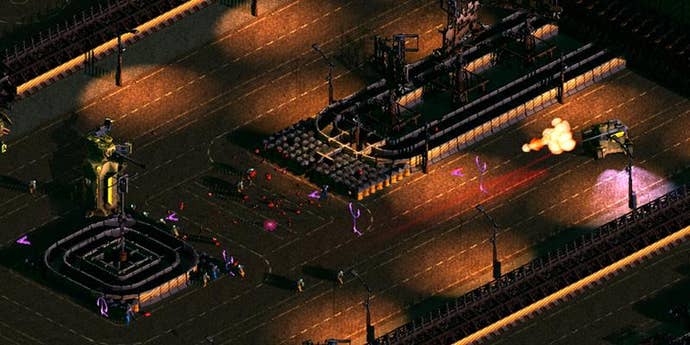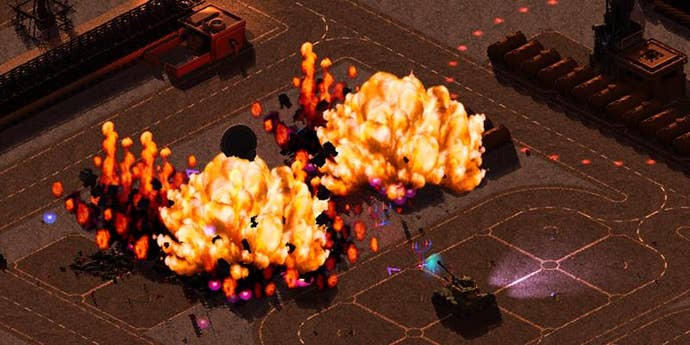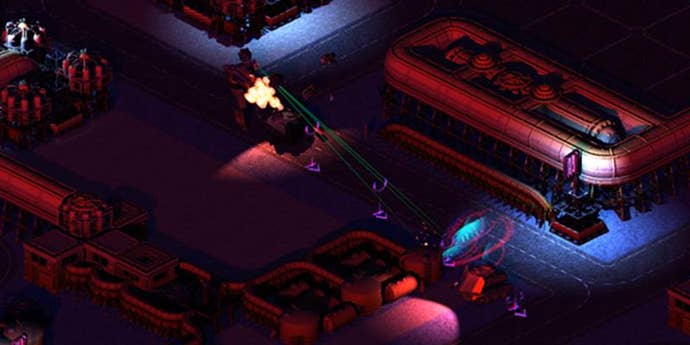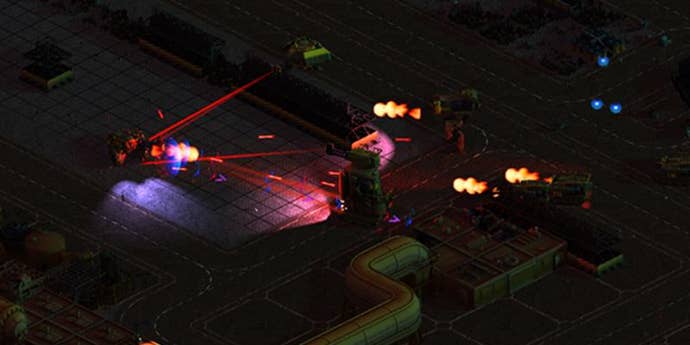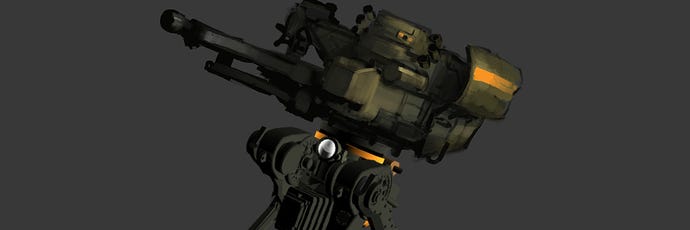Matador: the other mech game you should be hyped about
Matador is the isometric mech shooter that sees players attempting to liberate the city of Solo Nobre by blowing up everything in sight. Dave speaks with the team at Stellar Jockeys to discuss its street-levelling destruction, brutal challenges and much more.
Ah robots; there's something quite engrossing about them isn't there? At 30 I'm hardly old but even today I still get childish thrills whenever I watch Pacific Rim's hulking Jaeger mechs tearing through giant beasts, or at the sight of Arnie and T-1000 going at it in Terminator 2. Christ, I still get a lump in my throat at the bit in Short Circuit 2 when you think Johnny Five's headed off to the great scrapheap in the sky. It's bloody tragic.
Robots are universally awesome to a point, and indie developer Stellar Jockeys knows it. There's a time and place for robotic pathos, such as moral quandaries over augmentation in Deus Ex, or straight- mechanisation in Binary Domain, but this definitely isn't it. The studio wants you to act like an unstoppable machine of war as your mech tramples cars underfoot, levels the Solo Nobre streets with ease and brings total chaos to the entire city. Most importantly, they want you to feel f**king awesome doing it.
I was keen to know more, so I spoke with brothers Hugh and Jack Monahan on Google Hangouts about their background, Matador's development and what it's going to feel like stomping around town with a military pay-load at your fingertips. The entire recording is below if you want to listen to it podcast-style, or you can check out the feature below. It's the future, you have a choice.
(Hugh's the first guy talking, Jack's the second)
The game was Greenlit on Steam within two days of appearing there, although Jack told me that the team was expecting at least a two-week turnaround. Neither brother could believe it when Matador passed the voting stage, but it's not hard to see why looking at the game's aesthetic style and gameplay proposition.
For starters, it bears a neat, sprite-based artistic style reminiscent of old-school isometric games like Diablo and Syndicate. The pair told me that while the game's environs and elements bear 3D aspects, all of the visual elements are 2D. It's a style many veteran PC fans will surely appreciate.
”Win or lose; at the end of each run you’re going to see, tangibly, the destruction left in your wake. Matador is designed to be a hard-hitting game that rewards expression and tactics, but also twitch grace and skill. It’s one of those titles – much like Vlambeer’s Nuclear Throne – that will undoubtedly spawn a strong YouTube Let’s Play following.”
Jack explained that he was working on his own game project before Stellar Jockeys, something Hugh described as, "a top-down RTS with giant walking oil platforms and guns." We all laughed at his description, but this early design formed the basis of the Matador title you see today, and Jack added that the evolving concept saw the studio write its own engine, which is a useful approach in establishing an efficient team that knows its own tech inside and out.
"For me personally," Hugh explained, "the visual style of [the first] Diablo is actually one of my favourite games, along with the original Syndicate. It was one of those things where it was actually kind of a happy accident, because we built our own engine and it's sort of a running joke with us, because we are doing basically 3D, but in a 2D engine, and on a regular basis the programmers are like, 'seriously, why did we do this? Why isn't this game in 3D?'"
"The reason is," Jack added, "because basically the game wouldn't exist if it had to actually be 3D. What 2D workflow allows is the best of both worlds. You get to register sprites - they can be inter-penetrated like actual 3D - but a lot of the production headaches that come with making 3D stuff just aren't there. I don't have to worry about polygon counts, I don't have to UV map anything. It's incredible. There'd maybe be a tenth of the content if I had made this in 3D. It just wouldn't have happened."
Jack's got a good point in that there's a ton of content in Matador; perhaps more than you first realise. If you look at the teaser trailer below, you'll see swarms of big mechs returning fire at the player, car lots filled with parked vehicles that can be crushed, and a sea of buildings waiting to be broken. Now imagine if all of that were rendered in polygonal form. You'd be looking at serious frame-rate issues and draw distance problems. Don't forget that the Matador team is only four-strong, so it's clear why this was the best approach.
Turning to gameplay, Jack stressed that, "if it feels good to move and it feels good to shoot, you've got a game," and at base level that's fundamentally vital. Matador is a tensely-paced game with several rigs that move around the city in different ways. I was told there's a sense of great momentum to the way the robots move, and in the name of fair balance there's an anti-grav variety that - while faster and able to hover over low obstructions - suffers from unruly handling. This is all about weight, because you're piloting a machine that weighs several tonnes, not a fast-footed platform hero. Conveying that heft is important.
"We've really been trying to make sure that each of the different vehicle classes feels different," Jack explained, admitting that even he can't control the anti-grav vehicle all that well. "We're trying to espouse different player philosophies with each of the vehicle classes, and I think we've gotten it so far. Talking to different testers; they swear up and down that the vehicle they like is the best vehicle, which is a good sign: 'I will only play the tank; don't even talk to me.'"
The freedom of expression and choice is important to the Monahans, and this also enters into Matador's progression system. It doesn't strictly fall into the roguelike model, seeing as maps aren't randomised, but each run through each of the city's nine districts will be different due to how the game responds to your play-style, as well as featuring reshuffled enemy spawns. Each district serves as a level that will see players presented with three distinct objectives and while you only need to fulfil one to progress, you can go for whichever one you feel most comfortable with, or all three if you're feeling brave.
On the objectives Hugh explained, "One is to just murder everyone - take out the opposition, do the clean sweep," but Jack added that this used to be the only way you could play Matador initially, and Hugh conceded that it was too basic and mind-numbing to serve as the game's only task. "That was what we started with," Hugh continued, "and what we've expanded to is; there's also ammo depots scattered around every level.
"The 'saboteur' run is you go in and destroy the depots, and that also allows you to progress, but destroying a depot also aggros a bunch of enemies. There are different challenges presented by doing that kind of run. The third method is also destroying a building, except we're going to have these large, centralised installations in the middle of each district which have their own challenges."
Say, for example, you only go for the clean sweep and just kill everything in a district to proceed, the next district's enemies will become tougher. Likewise; if you simply destroy a district's fuel depots and nothing more, the next area's depots will be considerably better defended by more, aggressive foes. This is a way of stopping players from simply spamming the same approach on each play-through, and forces them to think smarter about their progression. Then there's the 'suicide' run which involved fulfilling all three objectives in every district. It's by far the hardest approach.
”Being smart in how you approach this force coming at you head-on is actually where the name Matador comes from. You’re the red rag; they’re the bulls, essentially.”
I suggested that this was similar to Hikoza T Ohkubo's free shmup Warning Forever - seriously play it, it's free and awesome - in which players fight a constant wave of bosses, and the brothers revealed that they're big fans.
In that game, say you concentrate most of your ship's fire on the bosses' right side; the next round will see it spawn in with more turrets and defences on that side. It's devilishly clever, and a format that bodes well for Matador's fast-paced, gruelling approach to difficulty.
Lastly; of course, you have different weapons and vehicles, and players are free to further express themselves by tailoring their craft's pay-load with straight-shooting cannons with limited ammo, to arced explosive rounds that prove a little trickier to aim, and everything inbetween. "What we're looking at is a balance," Jack explained, "because for me, one of my favourite games is still Hitman: Blood Money." He added that he always tells people that Blood Money is the finest RPG out there because of how much freedom is given to players to approach problems in their own way.
"We started with this normal run of different weapons," he went on, "you know; machine guns, cannons lasers, artillery weapons. The artillery weapon was especially a difficult one to figure out. Why does this exist? It's like, 'man I wish I could fire this cannon but I wish it could get there slower.' That doesn't really work from a design principle, but all of a sudden it actually starts to make sense if it says, 'what if it's actually a liability to be seen?'"
This means that the element of surprise is entirely valid in Matador. You can absolutely roll behind some buildings, out of sight, and fire an artillery strike over a building onto a pack of unaware enemy mechs. It seems that rushing in without a plan won't work in your favour here - seeing as most enemies have front-facing armour - but Jack was keen to refrain from calling the other approach 'stealth.'
It's not a stealth game, but there are ways to get your best foot forward before the enemy forces see or hear you. He revealed that being smart in how you approach this force coming at you head-on is actually where the name Matador comes from. You're the red rag; they're the bulls, essentially. That's important, because players can be clever enough to get enemy vehicles bogged-down in mud traps, stun them with smoke launchers and EMPs, or launch high-flying shells, only to hide before they come back down to earth. Deciding the best course of action under duress will be the key to surviving each district. Throw in custom Steam Workshop maps and you're going to have no end of challenges to contend with.
Win or lose, at the end of each run you're going to see, tangibly, the destruction left in your wake. Matador is designed to be a hard-hitting game that rewards expression and tactics, but also twitch grace and skill. It's one of those titles - much like Vlambeer's Nuclear Throne - that will undoubtedly spawn a strong YouTube Let's Play following. Hugh imagined players uploading clips of their best 'suicide' runs or play-throughs with an elephant gun-type weapon that is so loud it alerts every enemy in the district after just one shot. Players will devise their own strategies and express themselves on Stellar Jockey's canvas of metal, explosions and carnage.
Stay tuned for more on Matador as a playable build becomes available.
